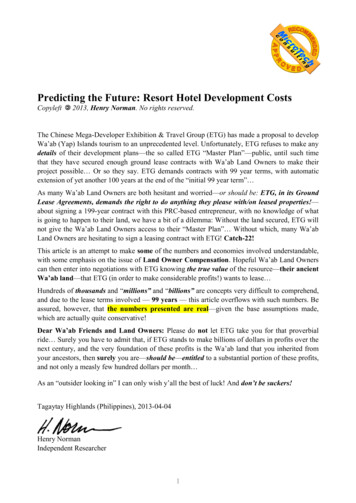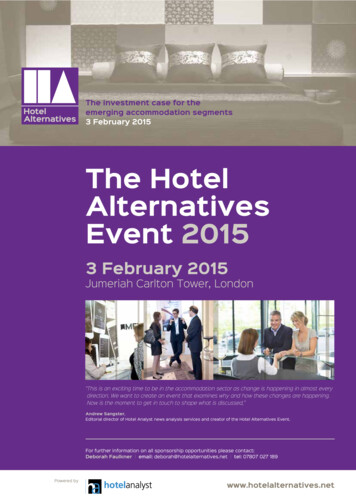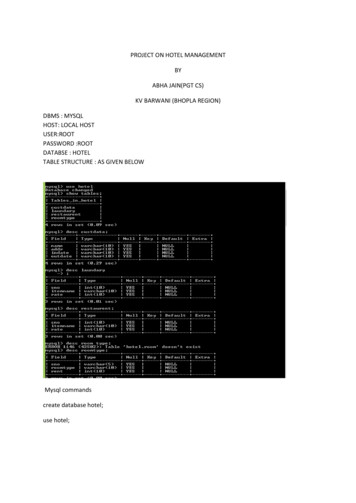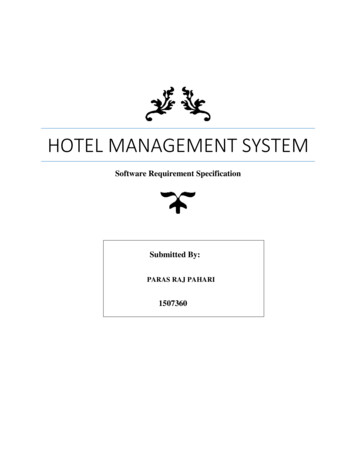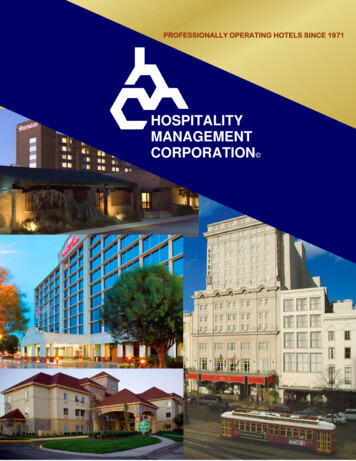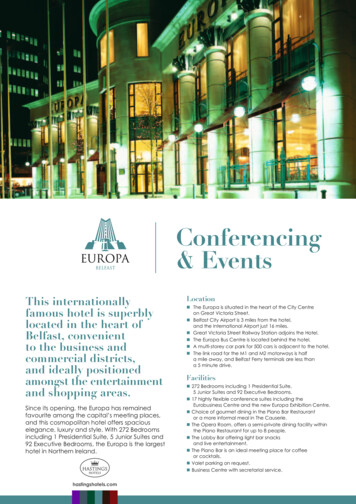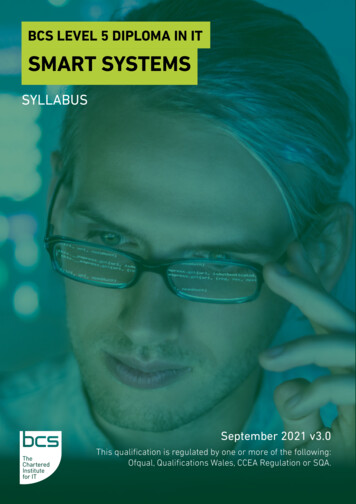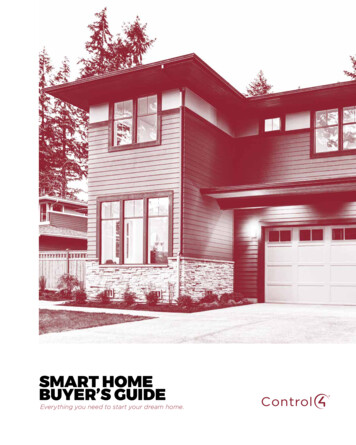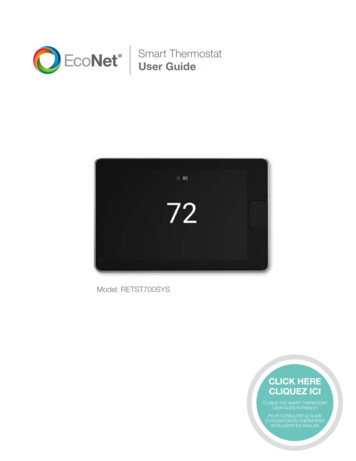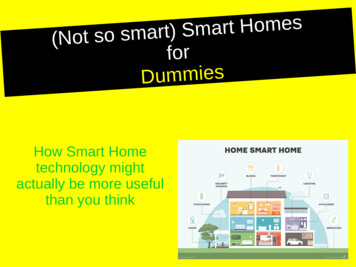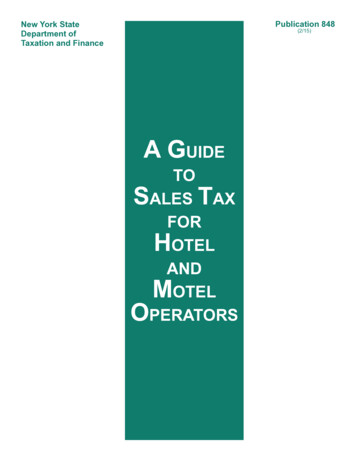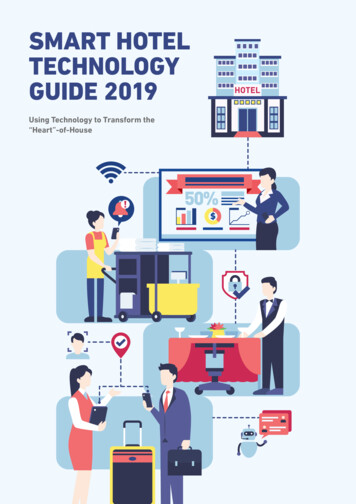
Transcription
SMART HOTELTECHNOLOGYGUIDE 2019Using Technology to Transform the“Heart”-of-House50%
CONTENTSOVERVIEW01About the Smart Hotel Technology GuideP.02Trends Shaping the Hotel IndustryP.03Moving Ahead with Innovation& TechnologyP.P.P.04To Begin Your Smart Hotel Journey06Sources of Information22Physical Security24Sales & Marketing / Revenue Management28Procurement & Finance30Human ResourcesTHE SMART HOTEL EXPERIENCE08Front OfficeP.12Food & Beverage / ABLING TECHNOLOGIES & CASE STUDIES34Data Analytics & Cloud TechnologyP.37Internet of Things (IoT)P.42RoboticsP.55Your TransformationJourney AwaitsP.P.P.P.55P.45Robotic Process Automation (RPA)49Video Analytics51Artificial Intelligence (AI) & Machine LearningAvailable GovernmentSupport and Toolkit58P.AcknowledgementsThe content of this guide is provided for informational purposes only and correct as of November 2019. The information found within has been collated by the Hotel InnovationCommittee (HIC) in good faith. Whilst all reasonable measures have been undertaken to ensure accuracy of the information, the HIC does not warrant and hereby disclaimsany warranty as to accuracy, correctness, reliability, timeliness or non-infringement for any particular purpose of the information in this guide. Users are encouraged to usethe information at their own discretion.
ABOUTTHE SMART HOTELTECHNOLOGY GUIDEInternational visitor arrivals from the Asia-Pacific are projected to grow by 5.5% annually from 2018 to20231, and Singapore’s tourism is poised for growth, with exciting tourism developments on the horizon.To ride this growth, the local hotel industry must continue to innovate and transform to seize opportunitiesand overcome challenges from increased competition, manpower shortage, and changing guest expectations.It is vital for hotels to understand and leverage emerging technologies to augment existing processes, as thiswill help optimise productivity, enhance service delivery, and ultimately, grow profitability.The Hotel Innovation Committee (HIC), led by the Singapore Hotel Association and supported by theSingapore Tourism Board, serves this need by identifying innovative solutions that will benefit andtransform the hotel industry.In 2018, the HIC launched the Smart Hotel TechnologyGuide 2018 to help hotels identify technologicalsolutions that can transform guest experiences in ninecritical guest journey segments.This year, the 2019 Guide was put together to help hotelstap data and Smart technologies to transform their“heart”-of-house – employees, processes, and overallbusiness growth. It also explores Smart ways to leveragedata and enabling technologies to assist sustainabilityefforts without compromising guests’ comfort.Transformation is rapidly disrupting the hospitality industry – and it is here to stay. Hotels can consult boththe 2018 and 2019 guides, which contain a series of technology solutions and case studies, for ideas on howto kick-start their Smart Hotel journey.1Pacific Asia Travel Association (PATA) Asia-Pacific Visitor Forecasts 2019–2023 Report01 SMART HOTEL TECHNOLOGY GUIDE 2019
TRENDS SHAPING THEHOTEL INDUSTRY01Digital technologies are shaping customers’ dailyexperiences, leading to higher expectationsCustomers’ everyday lives are being transformed by increased automationand artificial intelligence. They expect the same seamless and hyperpersonalised experiences when travelling, with businesses anticipatingtheir needs and offering consistent service.0203Millennial travellers prefer to spend on adventures rather than upscalehotel rooms.2Hotels are evolving their reward programmes to incorporate redemptionon travel experiences, e.g. Marriott Bonvoy Moments allows guests toredeem hotel stay points for culinary, entertainment, lifestyle and sportsevents, as well as experiences uniquely crafted for Marriott.Sustainability is now a priority67% of travellers are willing to spend at least 5% more on their travel toensure less impact on the environment.3Hotels are recognising that sustainability and competitiveness go hand inhand, and are taking action by adopting green policies, e.g. AccorHotelsestablished a Planet21 policy to achieve goals of food waste reduction andlow carbon buildings for 100% of new hotels by 2020.0405Travellers are seeking immersive and authentic experiencesWellness is going mainstream4US 919.4 billion projected value of the global wellness market by 2022.1.5 times more spending by a wellness traveller from the Asia-Pacificcompared with the average traveller.Growth of new business models disrupting accommodation options5Co-living spaces: Hotel brands are using innovative designs and technology-focusedamenities to reduce room sizes, but create huge communal spaces.Increasingly, co-working players are also expanding into co-living spaces.06Tight national workforce situationAgeing population.Competition from other sectors (including the gig economy) for same poolof workers.Tight Dependency Ratio Ceiling (DRC) for foreign labour in the services sector.The Wall Street Journal, “Millennials Prize Experience. Now So Do Travel Companies” (June 2019)Booking.com, “Sustainable Travel Report 2018”4Global Wellness Institute, “2018 Global Wellness Economy Monitor”5EHL, “Top 10 Trends Reshaping Hospitality in 2019” (2018)2302 SMART HOTEL TECHNOLOGY GUIDE 2019
MOVING AHEAD WITHINNOVATION & TECHNOLOGYHotels can leverage data and technology in an innovative way to move ahead in all aspects of the hospitality business –which includes fulfilling guest expectations, streamlining operations, improving pricing strategies and becoming friendlier tothe environment.FOR GUESTSHotels are guest-centric businesses – happy guests spendmore, and they will return. The Smart Hotel TechnologyGuide 2018 identified nine critical guest journey segments,where hotels can leverage technology to offer Smart anddifferentiated value propositions to engage guests andheighten experiences.CLICK HERE TO REFERTO THE 2018 GUIDE.FOCUS OF THE 2019 GUIDEFOR EMPLOYEESFOR HOTEL OWNERS AND OPERATORSThe hotel industry presents many opportunities to adopttechnology and innovation to drive operational efficiency.Currently, many hotel operations are labour-intensive,time-consuming and unproductive. Embracing technologyand automation in both the front and “heart”-of-housescan free employees to focus on providing quality, uniqueexperiences to guests.Technology and innovation offer a variety of cost savingsand revenue opportunities. They can also create newservices and offerings that were previously not possible,e.g. hotels can now engage visitors in their nativelanguages via chat-bots to facilitate service requests,improving guest experience and encouraging spending.It can also create a more conducive work environment,and help redesign jobs to meet the career expectations ofyounger job seekers.Overall, technology can help hotel owners reach newlevels of sustainability – in terms of the environment aswell as overall profits.03 SMART HOTEL TECHNOLOGY GUIDE 2019
TO BEGIN YOURSMART HOTEL JOURNEYAREAS OF OPPORTUNITIESThe 2019 Guide identifies eight common hotel functions and their respective processes that can leverage enablingtechnologies and solutions to unlock a combination of the following objectives:Becoming manpower leanDriving the top line efficiently and effectivelyEliminating non-value-adding processes and activitiesImproving environmental sustainabilityCommon Hotel Functions and ProcessesFrontOfficeF&B /BanquetCheckingIn & OutFood ll Service& ConciergeHousekeepingEngineeringRoom CleaningRepairs &MaintenanceAmenity &Linen DeliveryInventory &Asset TrackingKitchen& FoodManagementPublic AreaCleaningIn-RoomControlsPhysicalSecurityPatrols &SurveillanceMonitoringFacilities,Energy& WaterManagementSales &Marketing/ RevenueManagementProcurement& FinanceHumanResourcesPurchasingOn-BoardingHotel PricingStrategyAccounting& ReportingTraining &DevelopmentEvent & GroupBookingMarketing &UpsellingScheduling,Attendance &PayrollEmployeeEngagementInformation & Cyber SecurityData Analytics & ManagementSustainabilityDO YOU KNOW?The above functions represent typical departments in a hotel. However, hotels can rethink these traditional boundaries and assessopportunities to break them down to unlock smarter and more efficient processes – enabled by technology or job redesign.For instance:The IT department should not besolely responsible for implementinginnovation. Several hotels, e.g. GrandHyatt Singapore, Ritz Carlton MilleniaSingapore and the AccorHotelsSingapore group have an innovationteam comprising managers from eachfunction to look at adopting innovationfor improving productivity as a whole,within a service perspective.InterContinental Hotels Group andMarina Bay Sands Singapore setup their respective hotel data and/or analytics teams that look intocollection and analysis of all usefuldata – from operational analytics,process improvement to understandingcustomers’ needs. They then come upwith implementation strategies that canbenefit various hotel functions.Copthorne King’s Hotel Singaporecombines bellhop and security roles toincrease lobby workflow and providejob stability for employees.lyf Funan Singapore integrates the frontoffice, guest relations and marketingroles into a community manager role, or“lyfguard”, to empower employees andoptimise the level of service and guestexperience provided.Refer to “Available Government Support and Toolkit” on page 55 for more info on resources to guide hotels on job redesign.04 SMART HOTEL TECHNOLOGY GUIDE 2019
GUIDING POINTERS12Importance of data inevery hotel functionHumans first, alwaysIn many ways, technology and automation are helpinghotels return to their roots as a people-first industry. Withtechnology performing the repetitive, undesirable and lowvalue-adding work, employees can be more efficient andfocused on interacting face to face with guests.On top of driving operational efficiency, do consider ifthe technology can also achieve employee satisfaction– e.g. is the solution easy and intuitive to use? Will staffsupport be readily rendered during the transition? Whenemployees see value in adopting technology in their dailywork, they will stay in the job longer.3Cyber and data security needto be foundational capabilitiesPoor digital security and privacy may lead to potentiallegal and regulatory problems. Guests’ trust andconfidence in the hotel, and the hotel’s reputation, are alsolargely at risk should there be a security breach.It is therefore vital for hotels to develop a vision of theirdesired Smart Hotel that incorporates the above concernsand the hotels’ own characteristics. Once a vision isset, a hotel can then achieve it by adopting appropriatestructures and technology solutions to identify andaddress its key cybersecurity and privacy vulnerabilities.5Lastly, there is no one-sizefits-all list of best practices andSmart technologiesWhen adopting a solution, hotels should ensure that thenew and legacy systems can “talk” to each other in anintegrated and automated way. This helps to combine datasources and provide real-time analysis via easy-to-readdashboards. Hoteliers can then process data and make fastand informed decisions without having to rely on “gut” feel.Also, consider putting in place a strategy that ensures stafffrom all functions collect data continuously and granularly,and the data is accessible to everyone so that they cananalyse the data in ways relevant to their work.4Hotel leaders need to cultivate acollaborative, agile and calculated risktaking culture within the organisationIn fact, a hotel that encourages its teams to continuouslyexperiment with new ideas and scale up its successes(while allowing some room for failure) is en route tobecoming a successful Smart Hotel. Changes are faster,and the hotel will be more responsive to guests andemployees’ needs, enhancing business outcomes.Use this guideThis guide provides:Instead, hotels should assess their own areas of gaps andopportunities to create the right framework for success,before adopting technology solutions tailored to eachhotel’s unique set of challenges and performance metrics.Hotels can tap readily available resources from STB toassist in the process, such as the self-diagnostic toolkit(ready in 2020) that identifies gaps and opportunitiesfor hotels to implement digital solutions and buildcapabilities. Hotels can also attend the Tech College tolearn ways to ideate and develop action plans alignedwith their transformation vision.A description of Smart Hotel experiencesfor each of the eight hotel functionsA business case for each stage, and thecorresponding Smart experiencesInformation on available technologies toenable Smart Hotel experiencesCapabilities, benefits and considerations oftechnology implementationRelevant case studiesDetails of project implementation,outcomes and considerationsRefer to “Available Government Support and Toolkit” on page 55 for more info.Note: Information in this guide serves to act as a reference. Uses of technology and examples are non-exhaustive.05 SMART HOTEL TECHNOLOGY GUIDE 2019
12Interviews and focus groupdiscussions with hotel stakeholdersrepresenting over 30 hotels and hotelgroups in Singapore under local andinternational brandsLiterature anddesktop researchto gather informationand case studiesHotels’ keymanagement leadersand the SingaporeHotel AssociationTo understandbusiness imperativesand considerations inevolving into a SmartHotel from a back-ofhouse perspectiveTo ascertain areasof opportunities andoperational impactHotels’ heads ofdepartments &hospitality associationrepresentativesTo understand whata Smart Hotel meansfor each hotel functionTo identify existingoperational painpoints and areasof opportunities toimprove productivityand resourcemanagementTechnologyprofessionals workingfor hotelsTo identify bothtechnical andnon-technicalconsiderations whenadopting technologysolutionsTo understandrequirements andchallenges in selectingand implementingtechnology solutionsin the hotel context.3SOURCES OFINFORMATIONExpert inputs fromHospitality TechnologyNext Generation (HTNG)6on accuracy of contentregarding hotel technology6HTNG is a global non-profit organisation that fosters development of next-generation solutions through collaboration among professional andtechnology providers of hospitality.06 SMART HOTEL TECHNOLOGY GUIDE 2019
The Smart HotelExperiencep.08 Front Officep.12 Food & Beverage /Banquetp.16 Housekeepingp.19 Engineeringp.22 Physical Securityp.24 Sales & Marketing /Revenue Managementp.28 Procurement &Financep.30 Human Resources07 SMART HOTEL TECHNOLOGY GUIDE 2019
FRONT OFFICEBUSINESS CASEThe Front Office (FO) plays a vital role in ahotel, often being the first and last pointsa guest interacts with during the stay.According to Cornell’s Centre for HospitalityResearch, guest satisfaction decreasesby 47% once check-in takes more than 5minutes. The FO therefore needs to findways to provide a seamless experience forguests, leaving them with positive first andlast impressions, and converting them intoloyal return customers.AS SUCH, A SMART FO NEEDS TO:Be manpower leanEliminate activities that do notadd valueDrive top line efficientlyand effectivelyENABLING TECHNOLOGIESData Analytics &Cloud TechnologyInternet of Things(IoT)Robotic ProcessAutomation (RPA)Video Analytics08 SMART HOTEL TECHNOLOGY GUIDE 2019RoboticsArtificialIntelligence (AI) &Machine Learning
THE SMART HOTEL EXPERIENCECHECKING IN & OUTTHE COMMON EXPERIENCE TODAYA SMART HOTEL EXPERIENCECheck-in processFO staff log onto the property management system(PMS) at the front desk to register all check-in guestsone by one, causing a long wait, especially duringpeak hours.Once guests enter the lobby, Smart cameras withfacial-recognition capabilities recognise them fromthe passport photo submitted during mobile check-inprior to arrival. Guests’ mobile keys are then activatedautomatically, allowing them to bypass the FOcompletely and head up to their rooms.The FO team does not know exactly when guestswill arrive, hence it cannot anticipate the manpowerrequired at different times of the day.The housekeeping team also does not know whichrooms to clean first. If a room is not ready when theguest arrives, FO staff have to call the housekeepingteam to clean that room first.As guests share their arrival times during mobilecheck-ins, the FO team anticipates peak periods androsters staff accordingly. The housekeeping supervisoraccesses the arrival timings on the e-housekeepingapp too and prioritises the cleaning of certain rooms,reducing guests’ waiting time.FO staff can check in guests early but cannot issuetheir room keys when their rooms are not yet ready.When they return, their profiles must be re-opened toverify their details again, before programming the keycards, resulting in twice the amount of time spent oneach guest.FO staff check in early guests as normal, giving thema set of non-programmed room keys. Once the roomis ready, the PMS will automatically send a notificationto the guest via Robotic Process Automation (RPA).They can activate their mobile keys or tap in at a kiosk,bypassing FO staff.Physical check-outDuring check-out, FO staff have to manually inputthe payment amount into the electronic data capture(EDC) terminal to make the credit-card transaction.After the transaction is approved, the staff has toinput the EDC arrival code manually into the PMS toend the payment process.After the guest has confirmed the amount, the FOstaff clicks the “confirm” button on the PMS, andthe payment gateway integrated with the PMSautomatically inputs it into the EDC terminal. The PMSis updated automatically with the approval code oncethe transaction goes through.This process is compulsory even if the guest’s carddetails were already provided via online booking.Express or mobile check-outWhen guests drop their key cards in the expresscheck-out box, FO staff manually retrieve the keysand check the rooms out one by one on the PMS. Thisresults in the guests’ check-out being reflected in thePMS later than the physical check-out, delaying theroom cleaning and causing longer turnaround time.Guests who booked via the hotel website already havetheir credit-card details tokenised and safely storedin the PCI and PSD2-compliant payment gateway. FOstaff can just settle the check-out payment using thetokenised details without guests having to presenttheir cards again.When guests check out via mobile app, or droppingkey cards into the express check-out box embeddedwith RFID reader, it will detect the room number andcheck it out via the PMS. The RPA software will thenautomatically update the room status in real time sostaff can prepare for the next arrival.09 SMART HOTEL TECHNOLOGY GUIDE 2019
THE SMART HOTEL EXPERIENCELOYALTY PROGRAMMETHE COMMON EXPERIENCE TODAYA SMART HOTEL EXPERIENCERecognising loyalty membersDue to the lack of integration between the PMS andCustomer Relationship Management System (CRMS),FO staff who do not refer to the CRMS at check-inmight miss guests’ loyalty membership details. Thus,guest relations staff will look through the list ofarriving guests every day to identify loyalty members,then add a prompt in the PMS to highlight their statusduring check-in.Integrated with the CRMS, the Smart camera withfacial-recognition capabilities also helps identifyloyalty members and repeat guests when they enterthe hotel lobby, alerting FO staff to greet them in apersonalised and timely manner.Customised upsellingBased on the limited information FO staff have onguests, they can only upsell generic hotel offerings.By recognising the guests, the Smart CRMS willalso extract their preferences to assist FO staff inconducting targeted upselling, boosting potentialrevenue. For instance, if the CRMS captures that aguest always ordered alcohol during his past stays, FOstaff can ask if he would like to upgrade to a room withclub access, where he can enjoy unlimited drinks.BELL SERVICE & CONCIERGETHE COMMON EXPERIENCE TODAYA SMART HOTEL EXPERIENCEBell serviceA bellhop manually transports luggage to the roomsvia the heavy luggage cart after being informed of theroom number.A bellhop no longer needs to make countless trips.He just loads the luggage onto an autonomous cartintegrated with the lifts that will deliver them securelyto the rooms.Upon check-out, the bellhop manually collects thesuitcases, ties paper tags on them and passes theother half of the tag to the guests for them to presentupon retrieval. He then places the suitcases in thestoreroom and manually searches for them uponretrieval. The process could result in a long waitduring peak hours.Upon check-out, guests can store their luggage byactivating the automated baggage storage systemusing facial recognition. The system will store theluggage efficiently in the storeroom via robotic armsafter security screening.ConciergeThe concierge recommends itineraries to guests, butsometimes is unable to provide updated informationdue to the sudden closure of an attraction orrestaurant, leading to dissatisfied guests.The concierge often has to answer simple andrepetitive questions, and is unable to help guests withmore demanding or special requests.AI-enabled chat-bots integrated with STB’s TourismInformation and Services Hub (TIH) via APIs canprovide guests with up-to-date, real-time itineraries,as well as recommendations to enhance their stay. Theconcierge thus has more time for guests with morecomplicated queries.The concierge can also leverage data collected bythe chat-bots through past guest interactions andits monitoring of social media channels to anticipatepotential problems, and customise services accordingly.10 SMART HOTEL TECHNOLOGY GUIDE 2019
DO YOU KNOW?Launched by STB, the Tourism Information & Services Hub (TIH) is a freeone-stop B2B platform for tourism businesses to directly connect, access,and share Singapore destination content and travel software services.The TIH powers the Visit Singapore mobile app, as well as otherbusinesses’ digital platforms, helping our tourism businesses achievegreater outreach to global audiences.Be part of the TIH today!REGISTERREGISTERREGISTERStep 1Step 2Step 3Register for a freeTIH account.You will need yourCorpPass account.List your hotels’products & offeringsregularly and/ordownload relevanttourism information.Sync directly with the TIH viaApplication Programming Interface(API) to tap real-time tourisminformation updates and ready-to-usetravel software services.REGISTERWhatare the featuresin the TIH?Updated destination content in 11 categories suchas F&B, Retail, Tours, Events and Walking Trails,supported in 5 languages (English, Simplified andTraditional Chinese, Japanese and Korean).How does the TIH benefithotel businesses?Delivers real-time information of your hotel’sroom rates and products (e.g. events and uniqueexperiences) to a previously untapped audience.Attribution-free digital assets e.g. videosand images.Enhances guest satisfaction by creating for themcustomised maps and precinct guides via the hotel’sown digital channels and/or concierges.Ready-to-use travel software services for yourhotel’s front-end digital platforms, e.g.:Boosts productivity by connecting hotel systemsdirectly to the TIH via APIs, e.g.:Enhanced navigation serviceRecommendation engineSmart itinerary plannerVisit Singapore Account, a single digital token thathotels can integrate as a mode of login on yourdigital platform to gather deeper insights andpush personalised recommendations to guestsReduces the number of repetitive guest enquiriesanswered by concierge staffRemoves the need for marketing staff to frequentlyresearch and update content across platformsProvides the sales and marketing team insightsinto local visitors’ preferencesClick here to refer to the TIH Toolkit for more information11 SMART HOTEL TECHNOLOGY GUIDE 2019
FOOD & BEVERAGE /BANQUETBUSINESS CASEIncreasingly, travellers are not just lookingfor a place to stay. They are also willing tospend more on food and beverage (F&B)options, giving hotels opportunities to netextra revenue.7 With both F&B and Banquetfunctions becoming major contributorsto a hotel’s positioning, hotels should notoverlook their ability to provide high-qualityfood and efficient dining.HOWEVER, WITH RISING COSTS AND ATIGHT MANPOWER SITUATION, SMART F&BAND BANQUET FUNCTIONS NEED TO:Be manpower leanAutomate activities that do notadd valueReduce operating costsENABLING TECHNOLOGIESData Analytics &Cloud TechnologyInternet of Things(IoT)Robotic ProcessAutomation (RPA)7Video AnalyticsRoboticsArtificialIntelligence (AI) &Machine LearningHospitality Net, “Food and Beverage Boosts Hotel Revenue” (2019) and CBRE Hotels’ Americas Research, “Trends in the Hotel Industry” (2017)12 SMART HOTEL TECHNOLOGY GUIDE 2019
THE SMART HOTEL EXPERIENCEFOOD SERVICETHE COMMON EXPERIENCE TODAYA SMART HOTEL EXPERIENCETable managementF&B staff log on to different devices, reservationaccounts and emails to check and consolidatereservations from various platforms into the hotel’sown table management system.F&B staff log on to only one table managementsystem that is integrated with various diningreservation platforms to view all reservationsand approve the system-suggested table seatingarrangement for the next meal service.Daily breakfast service is usually hectic, with a largevolume of guests and long waiting times as staff haveto verify guests’ breakfast entitlements against aprinted list.F&B staff can detect guests’ breakfast entitlementsinstantly via facial-recognition cameras placed atF&B outlet entrances.F&B staff have to walk around to search for availabletables, flag them for cleaning, then manually indicatethat they are ready in the table management systembefore another staff member brings a guest in.“Open” tables are viewed in real time through amobile table management system integrated withvideo analytics capabilities. Smart cameras canidentify vacant tables and notify staff to clean them.The camera then identifies an object placed by staffon the clean table and flags it as “open” in the system.OrderingF&B staff are constantly looking out for guests totake orders or assist them. Sometimes, due to atight manpower situation, guests wait for a long timebefore being served.With wireless e-menus, orders can be placed viamobile devices in a timely fashion with fewer errors.The menus can also be updated in real time (e.g.depending on availability of ingredients), and areintegrated seamlessly with the kitchen managementand Point-Of-Sale (POS) systems. F&B staff do notneed to physically share orders with the kitchen andcreate a billing invoice in the POS.PaymentF&B staff have to reconcile all food orders made intothe POS and print a bill for the guest to pay or chargeto the room. Staff will then manually tally closingfigures at the end of each shift.Since all F&B systems are integrated, the POS willcreate the bill seamlessly, and instead of taking outtheir wallets, guests pay via facial recognition or taptheir keys with stored tokenised payment data.The CRMS, integrated with the cameras, will help F&Bstaff recognise and greet loyalty members and repeatguests, customise F&B promotions to entice spendingand offer giveaways to enhance their experience.Staff also do not need to tally closing figures manuallyas the integrated payment gateway will automaticallyreconcile each transaction (i.e. check consistencybetween the sales report and payment requests onPOS). F&B staff need only manage exceptions.13 SMART HOTEL TECHNOLOGY GUIDE 2019
THE SMART HOTEL EXPERIENCEIN-ROOM DININGTHE COMMON EXPERIENCE TODAYOrderingF&B staff write food orders on paper after receivinga call from the guest, and convey the order to thekitchen verbally. Staff then manually input the billcharges into the POS.In-room deliveryF&B staff will physically push the in-room diningtrolley into the room to deliver the order. However,staff have to check every floor with in-room diningrequests, as they will not know when to collect thetrays or trolleys afterwards.A SMART HOTEL EXPERIENCEGuests place their orders via the in-room chat-botintegrated with the POS and kitchen managementsystem, which will send orders and billing directlyto the POS and kitchen respectively. Staff will tendto guests’ calls only when the chat-bot cannot assistwith their requests.F&B staff will place the order in a secureautonomous in-room dining robot for delivery to therooms. Guests unlock the robot via facial recognitionor their keys to retrieve the food. The tray, fitted withSmart IoT sensors, will automatically notify the robotonce placed outside the room for collection.BANQUET SETUPTHE COMMON EXPERIENCE TODAYA SMART HOTEL EXPERIENCEThe banquet team manually lifts the heavy and bulkyfurniture needed (e.g. big round tables, chairs, stageplatform) onto a cart and physically pushes theheavy cart back and forth from the storeroom to thefunction area.Banquet staff stack heavy tables and chairs on alightweight autonomous cart to bring them from thestoreroom to event venue with little effort.Banquet staff then carry the tables to designatedspots according to the floor plan, manually foldeach napkin, and set up tableware and glasswareon each table. This task is both time consuming andlabour intensive.The setup process becomes easier; staff lift thetables from the cart and place them at a staging spotto set up the tableware, glassware and napkins foldedby the automated napkin-folding machine. Theautonomous banquet robot will then lift and movethe fully set-up table to its designated spot accordingto the floor plan. A similar robot moves chairs andother furniture to their designated positions too.After the event, the same robot will move the tablesback to the same staging spot, where staff can easilydismantle the setup.14 SMART HOTEL TECHNOLOGY GUIDE 2019
T
It is vital for hotels to understand and leverage emerging technologies to augment existing processes, as this will help optimise productivity, enhance service delivery, and ultimately, grow profitability. . Hotels can leverage data and technology in an innovative way to move ahead in all aspects of the hospitality business - which includes .
